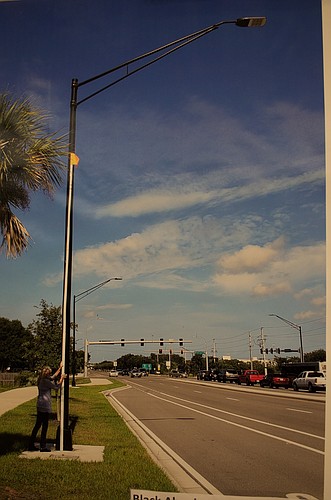- December 19, 2025
-
-
Loading

Loading

A consensus on how high above the ground to build smart streetlights and 4G small-cell transmission equipment will allow the town now to move forward with the design of its project to bury power and communications cables underground.
Commissioners on Monday gave an informal OK to these initial standards for poles to support the cell devices:
The timing of the town commissioners’ consensus was critical to keep the planning and design of the $40 million project moving forward. Completion could be accomplished by 2022.
“Without this, we cannot proceed further with the design of that effort, and hence that hampers our ability to launch full scale construction of that project, which we’d like to start in June,’’ Public Works Director Isaac Brownman said at a workshop meeting. The formal vote to give direction on the height and aesthetics will come in June.
Commissioners have been discussing the height of the poles since February, balancing technical specifications with residents’ concerns about aesthetics.
The decision to move ahead at 35 feet and 25 feet is driven by data and finance. A radio frequency study of cell-phone reception across the island was completed in March by town consultant Waterleaf International LLC to establish a baseline of cell-service and also model the performance of a small-cell network with transmission gear mounted 35 feet and 25 feet above the ground.
Commissioners also ordered a parallel study of poles 25 feet and 15 feet in height, based on resident requests. The lower options didn’t test well, officials said.
“You’d have to use a lot more poles to cover what one pole could do at 35 feet than what the others could do at 15 feet,’’ said Adam Sewall, president and CEO of Waterleaf International, adding buildings and vegetation can block cell signals, making clear the need to get above obstructions. “There’s a dramatic difference between height increase.’’
Waterleaf data indicates the town would require 72 small-cell poles using 35- and 25-foot poles (27 along Gulf of Mexico Drive, 23 in the neighborhoods and 22 behind the gates of private neighborhoods). With 25- and 15-foot heights, 113 would be needed.
The price is a difference, too: $1.44 million versus $2.26 million.
With the height determined and the number of small-cell poles calculated, the network designers will first look at where streetlights must go on the state-maintained Gulf of Mexico Drive, as mandated by Florida Department of Transportation: signalized intersections and mid-block crosswalks. The town also wants to light a few more areas with FDOT-approved lights.
Those poles are positioned in the design first. Then designers can spot the cell-equipped poles optimally along GMD for the best service. Beyond that, more poles will be interspersed with smaller-scale lighting for sidewalks. All the poles – about 130 of them, with or without cell gear or FDOT street lights – can host a variety of technology such as cameras, traffic sensors or other devices and be updated with 5G gear in the future.
The small-cell poles would be about 1,200 to 1,500 feet apart, whether they have streetlights or not.
“Let’s say Centre Shops,’’ Brownman said. “You wouldn’t have one light pole, you might have four or six. You don’t need all of them smart